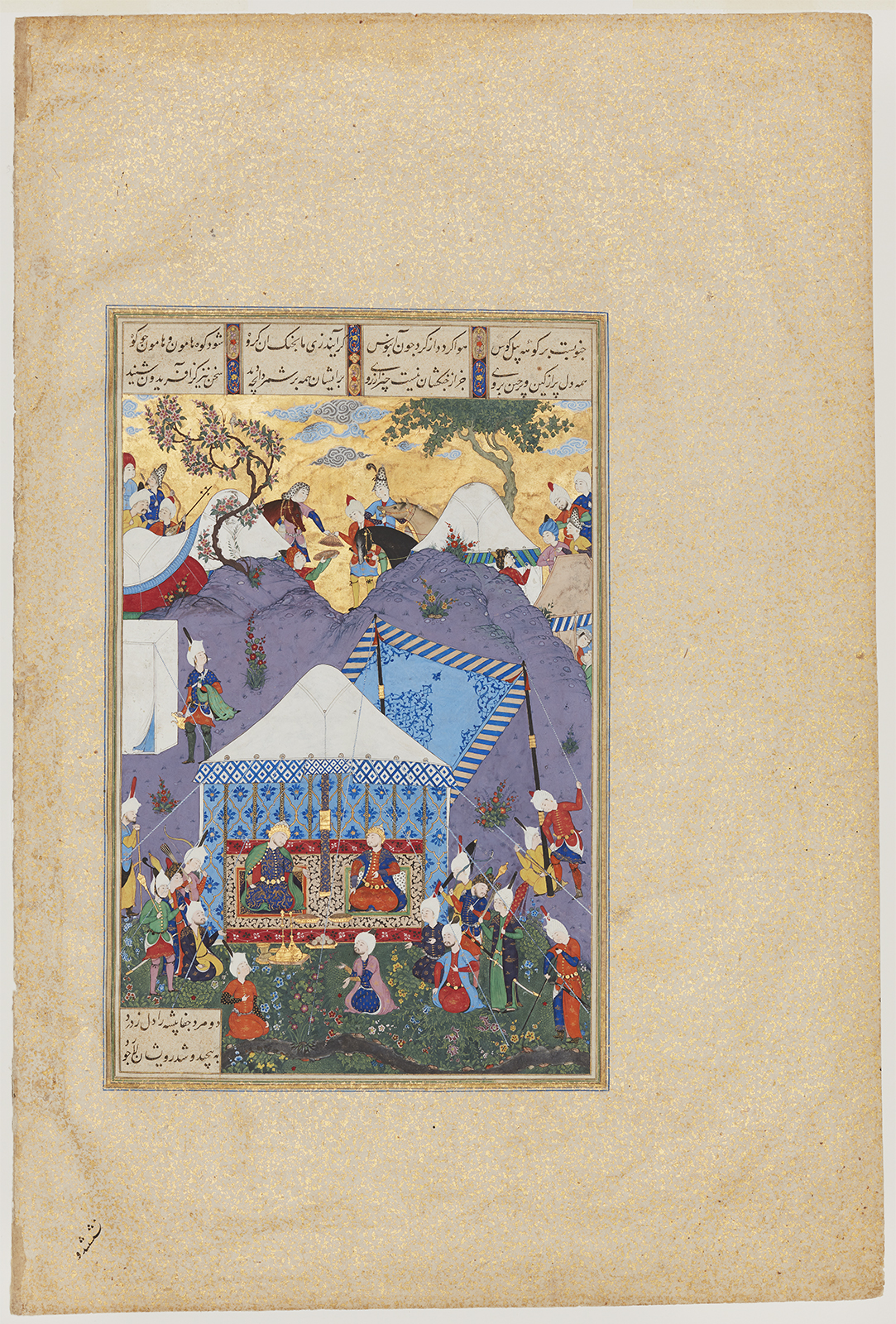Click on the image to zoom
Salm and Tur Receive the Reply of Faridun and Manuchihr
Folio from the Shahnameh (Book of Kings) of Shah Tahmasp
- Accession Number:AKM495
- Creator:Attributed to ‘Abd al-‘Aziz
- Place:Iran, Tabriz
- Dimensions:47.1 x 32 cm
- Date:ca. 1522–1535
- Materials and Technique:Opaque watercolour, ink, and gold on paper
Completed in 1010, the Shahnameh (Book of Kings) by the poet Firdausi recounts the history of all of Iran’s shahs (kings) up to the Arab conquest in 642 AD and the country’s adoption of Islam. The Shahnameh produced for Shah Tahmasp (r. 1524-76), second shah of the Safavid dynasty, represents the pinnacle of Iranian painting. Attributed to ‘Abd al-‘Aziz, AKM495 (folio 53 verso) continues the story of King Faridun’s sons, Salm, Tur, and Iraj (see AKM903). Salm and Tur resented the decision of their father, Faridun, to grant Iran to their younger brother, Iraj. Threatening to wage war against Iraj, the brothers plotted his demise, and when he came to negotiate with them, Tur murdered him. Grief-stricken, Faridun resolved to teach Manuchihr, the young grandson of Iraj, all the arts of kingship, including those of war. When Salm and Tur learned that Manuchihr was preparing to avenge his grandfather’s death, they sent an envoy to Faridun with a message expressing their wish for forgiveness and their loyalty to Manuchihr. Faridun menaced war against the brothers by all the most powerful men in Iran, with Manuchihr at the head of the army. Returning to Salm’s encampment, the fearful envoy eventually relayed Faridun’s message, causing Salm and Tur’s faces to turn “blue as lapis lazuli.”[1]
See AKM155 for an introduction to The Shahnameh (Book of Kings) of Shah Tahmasp
Further Reading
‘Abd al-‘Aziz captures the moment when Tur and elder brother Salm learn that Iraj’s grandson Manuchihr is preparing to avenge his grandfather’s murder. He does not give the princes blue skin, but conveys the intensity of their discussion by the hand gestures of the brother on the left and the envoy kneeling before them, as well as by the courtiers seated closest to their tent. The tent enclosing Salm and Tur is placed slightly off-centre, while the two hillocks in the background and the tents and figures behind them extend the sense of the two brothers’ camps having joined for this meeting. This theme is expressed by a woman and boy from the left-hand group offering a platter of food to the right-hand followers in the notch of the hills.
‘Abd al-‘Aziz is believed to have produced this painting under the direction of Sultan Muhammad, who created “The Court of Kayumars” (AKM165) and other memorable paintings in the Shah Tahmasp Shahnameh. In keeping with the style of Sultan Muhammad, this folio includes many small figures who are ancillary to the composition. It also includes figures familiar from Sultan Muhammad’s other Shahnameh paintings, such as the bearded man standing at the edge of the page with his hands resting on a staff and the man with a jutting chin in the upper right who wears a leopard-skin cap.
As with most of the illustrations in the Shahnameh of Shah Tahmasp, this folio contains numerous details that lend insight into the material culture of 16th-century Iran. The main tent is designed for an audience, open across one side so its panels of blue and gold lining are visible. Extant Safavid tent panels are made of velvet, but cotton, linen, and silk were used by the Ottomans and may well have been found in Safavid tents as well.[2] The awning erected behind the tent would have kept direct sunlight off the tent and at times could have been employed for shading a king or prince. At the left edge of the scene in the middle ground is a small rectangular tent with a flat roof. This would have been the latrine, with a servant standing by to help its users wash and dry themselves after use. Although the artist has not differentiated between the tent types of Turan, ruled by Tur, and those of Rum, Anatolia and the west, ruled by Salm, several variations appear along the horizon.[3] Since such utilitarian objects as tents rarely survived intact, this painting is a useful document of some of the features of Safavid encampments.
The Shahnameh produced for Shah Tamasp is represented in the Aga Khan Museum Collection by ten paintings (AKM155, AKM156, AKM162, AKM163, AKM164, AKM165, AKM495, AKM496, AKM497, AKM903) out of a total of 258 illustrations in the original manuscript.
— Sheila R. Canby
Notes
[1] The relevant hemistich of the poem referring to the brothers are blue-skinned appears in the text block at the lower left.
[2] See Atasoy 2000, 107–8.
[3] At the right edge the tent enclosing two women appears to be made of undyed cloth and has a flat top, whereas the two tents behind the peaks of the hillocks are probably round. Finally, the tent at the far left is red and bulbous, covered with a white tent roof that is draped over its neighbour.
Note: This online resource is reviewed and updated on an ongoing basis. We are committed to improving this information and will revise and update knowledge about this object as it becomes available.


